University Report: Virtual Marketing Compared to Traditional Marketing
VerifiedAdded on 2023/01/18
|6
|1202
|38
Report
AI Summary
This report compares and contrasts virtual marketing with traditional marketing approaches, arguing the benefits of virtual marketing in the current digital age. The introduction highlights the evolution of marketing alongside technological advancements and consumer behavior, emphasizing the increasing importance of digital platforms. The body of the report supports the preference for virtual marketing, pointing out the extensive use of the internet, smartphones, and social media. It discusses the cost-effectiveness and broader reach of virtual marketing and the use of web analytics to understand consumer preferences. The report also acknowledges the value of traditional marketing in specific contexts, such as building personal relationships with consumers. The conclusion reiterates the advantages of virtual marketing in the context of technological growth and its capacity to provide businesses with immediate customer access, while traditional marketing is time-consuming and costly. The report uses academic references to support its arguments.
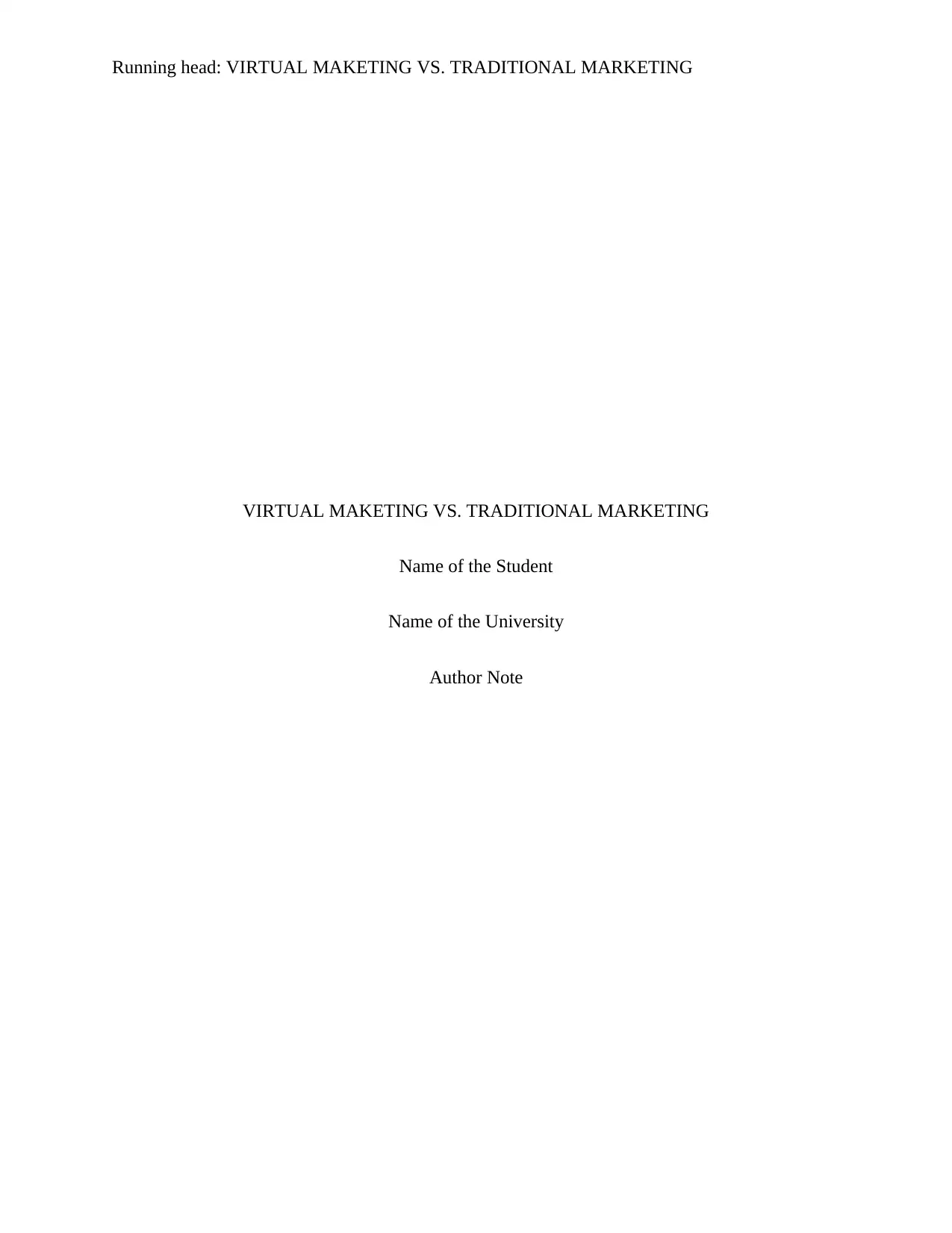
Running head: VIRTUAL MAKETING VS. TRADITIONAL MARKETING
VIRTUAL MAKETING VS. TRADITIONAL MARKETING
Name of the Student
Name of the University
Author Note
VIRTUAL MAKETING VS. TRADITIONAL MARKETING
Name of the Student
Name of the University
Author Note
Paraphrase This Document
Need a fresh take? Get an instant paraphrase of this document with our AI Paraphraser
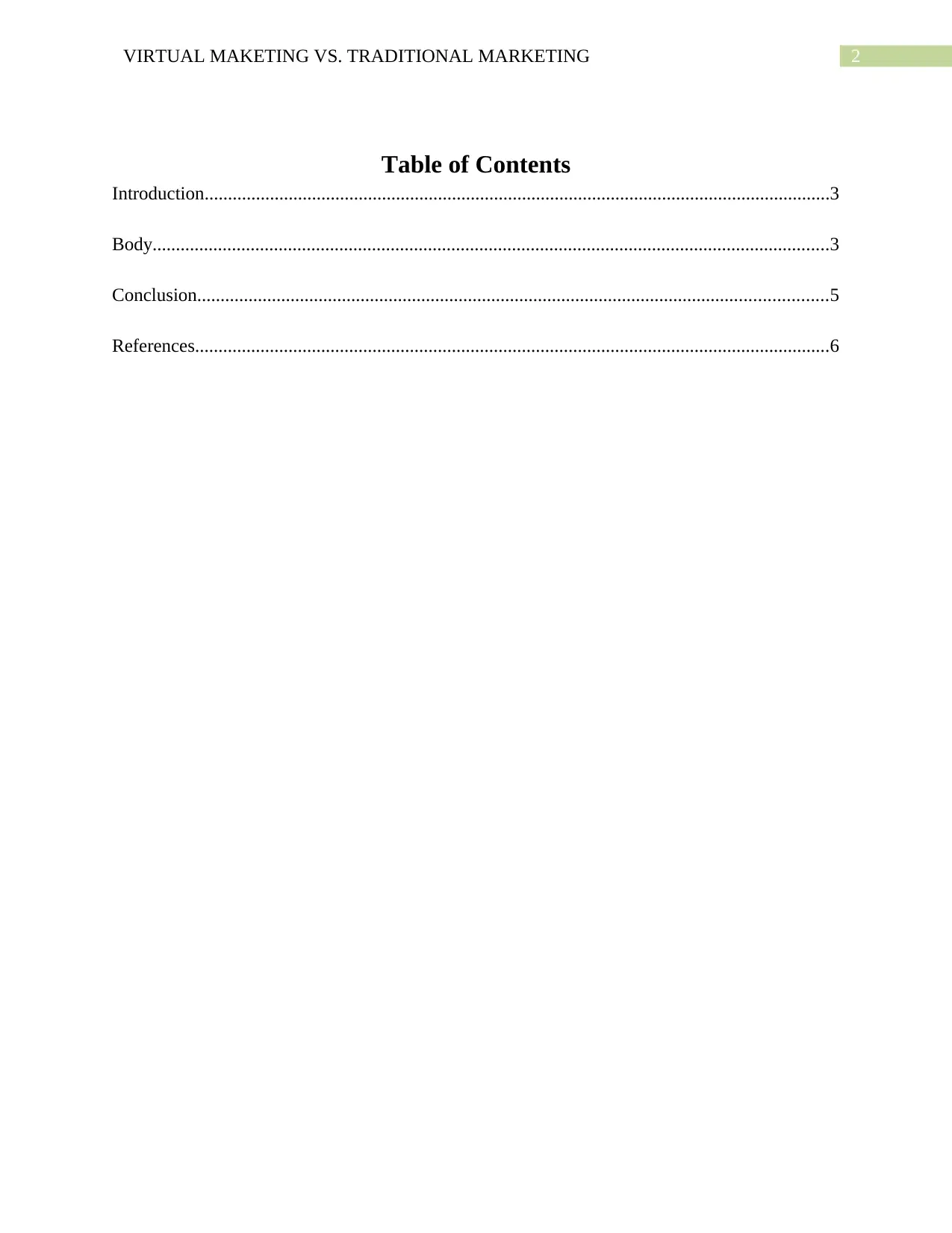
VIRTUAL MAKETING VS. TRADITIONAL MARKETING 2
Table of Contents
Introduction......................................................................................................................................3
Body.................................................................................................................................................3
Conclusion.......................................................................................................................................5
References........................................................................................................................................6
Table of Contents
Introduction......................................................................................................................................3
Body.................................................................................................................................................3
Conclusion.......................................................................................................................................5
References........................................................................................................................................6
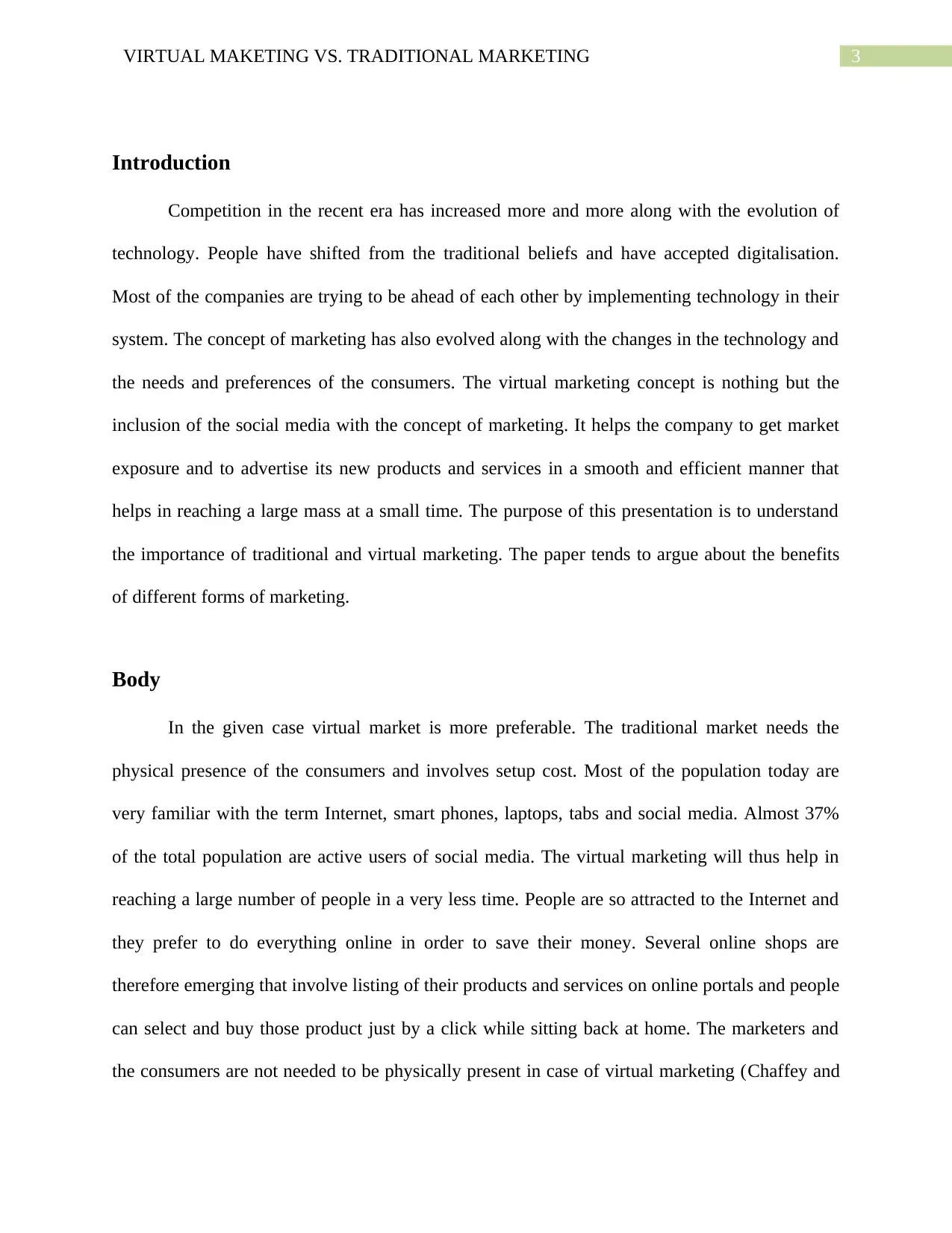
3VIRTUAL MAKETING VS. TRADITIONAL MARKETING
Introduction
Competition in the recent era has increased more and more along with the evolution of
technology. People have shifted from the traditional beliefs and have accepted digitalisation.
Most of the companies are trying to be ahead of each other by implementing technology in their
system. The concept of marketing has also evolved along with the changes in the technology and
the needs and preferences of the consumers. The virtual marketing concept is nothing but the
inclusion of the social media with the concept of marketing. It helps the company to get market
exposure and to advertise its new products and services in a smooth and efficient manner that
helps in reaching a large mass at a small time. The purpose of this presentation is to understand
the importance of traditional and virtual marketing. The paper tends to argue about the benefits
of different forms of marketing.
Body
In the given case virtual market is more preferable. The traditional market needs the
physical presence of the consumers and involves setup cost. Most of the population today are
very familiar with the term Internet, smart phones, laptops, tabs and social media. Almost 37%
of the total population are active users of social media. The virtual marketing will thus help in
reaching a large number of people in a very less time. People are so attracted to the Internet and
they prefer to do everything online in order to save their money. Several online shops are
therefore emerging that involve listing of their products and services on online portals and people
can select and buy those product just by a click while sitting back at home. The marketers and
the consumers are not needed to be physically present in case of virtual marketing (Chaffey and
Introduction
Competition in the recent era has increased more and more along with the evolution of
technology. People have shifted from the traditional beliefs and have accepted digitalisation.
Most of the companies are trying to be ahead of each other by implementing technology in their
system. The concept of marketing has also evolved along with the changes in the technology and
the needs and preferences of the consumers. The virtual marketing concept is nothing but the
inclusion of the social media with the concept of marketing. It helps the company to get market
exposure and to advertise its new products and services in a smooth and efficient manner that
helps in reaching a large mass at a small time. The purpose of this presentation is to understand
the importance of traditional and virtual marketing. The paper tends to argue about the benefits
of different forms of marketing.
Body
In the given case virtual market is more preferable. The traditional market needs the
physical presence of the consumers and involves setup cost. Most of the population today are
very familiar with the term Internet, smart phones, laptops, tabs and social media. Almost 37%
of the total population are active users of social media. The virtual marketing will thus help in
reaching a large number of people in a very less time. People are so attracted to the Internet and
they prefer to do everything online in order to save their money. Several online shops are
therefore emerging that involve listing of their products and services on online portals and people
can select and buy those product just by a click while sitting back at home. The marketers and
the consumers are not needed to be physically present in case of virtual marketing (Chaffey and
⊘ This is a preview!⊘
Do you want full access?
Subscribe today to unlock all pages.

Trusted by 1+ million students worldwide
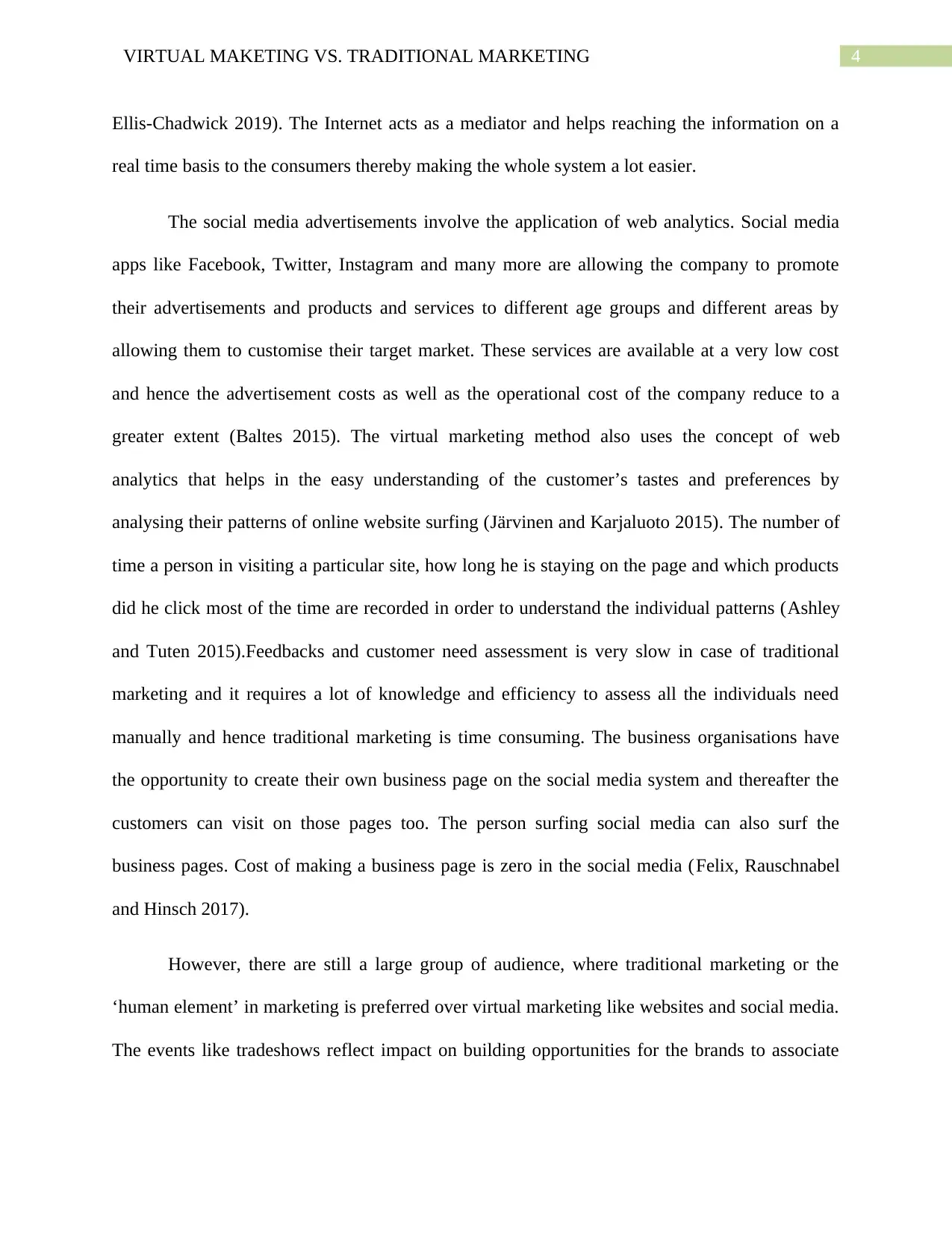
4VIRTUAL MAKETING VS. TRADITIONAL MARKETING
Ellis-Chadwick 2019). The Internet acts as a mediator and helps reaching the information on a
real time basis to the consumers thereby making the whole system a lot easier.
The social media advertisements involve the application of web analytics. Social media
apps like Facebook, Twitter, Instagram and many more are allowing the company to promote
their advertisements and products and services to different age groups and different areas by
allowing them to customise their target market. These services are available at a very low cost
and hence the advertisement costs as well as the operational cost of the company reduce to a
greater extent (Baltes 2015). The virtual marketing method also uses the concept of web
analytics that helps in the easy understanding of the customer’s tastes and preferences by
analysing their patterns of online website surfing (Järvinen and Karjaluoto 2015). The number of
time a person in visiting a particular site, how long he is staying on the page and which products
did he click most of the time are recorded in order to understand the individual patterns (Ashley
and Tuten 2015).Feedbacks and customer need assessment is very slow in case of traditional
marketing and it requires a lot of knowledge and efficiency to assess all the individuals need
manually and hence traditional marketing is time consuming. The business organisations have
the opportunity to create their own business page on the social media system and thereafter the
customers can visit on those pages too. The person surfing social media can also surf the
business pages. Cost of making a business page is zero in the social media (Felix, Rauschnabel
and Hinsch 2017).
However, there are still a large group of audience, where traditional marketing or the
‘human element’ in marketing is preferred over virtual marketing like websites and social media.
The events like tradeshows reflect impact on building opportunities for the brands to associate
Ellis-Chadwick 2019). The Internet acts as a mediator and helps reaching the information on a
real time basis to the consumers thereby making the whole system a lot easier.
The social media advertisements involve the application of web analytics. Social media
apps like Facebook, Twitter, Instagram and many more are allowing the company to promote
their advertisements and products and services to different age groups and different areas by
allowing them to customise their target market. These services are available at a very low cost
and hence the advertisement costs as well as the operational cost of the company reduce to a
greater extent (Baltes 2015). The virtual marketing method also uses the concept of web
analytics that helps in the easy understanding of the customer’s tastes and preferences by
analysing their patterns of online website surfing (Järvinen and Karjaluoto 2015). The number of
time a person in visiting a particular site, how long he is staying on the page and which products
did he click most of the time are recorded in order to understand the individual patterns (Ashley
and Tuten 2015).Feedbacks and customer need assessment is very slow in case of traditional
marketing and it requires a lot of knowledge and efficiency to assess all the individuals need
manually and hence traditional marketing is time consuming. The business organisations have
the opportunity to create their own business page on the social media system and thereafter the
customers can visit on those pages too. The person surfing social media can also surf the
business pages. Cost of making a business page is zero in the social media (Felix, Rauschnabel
and Hinsch 2017).
However, there are still a large group of audience, where traditional marketing or the
‘human element’ in marketing is preferred over virtual marketing like websites and social media.
The events like tradeshows reflect impact on building opportunities for the brands to associate
Paraphrase This Document
Need a fresh take? Get an instant paraphrase of this document with our AI Paraphraser
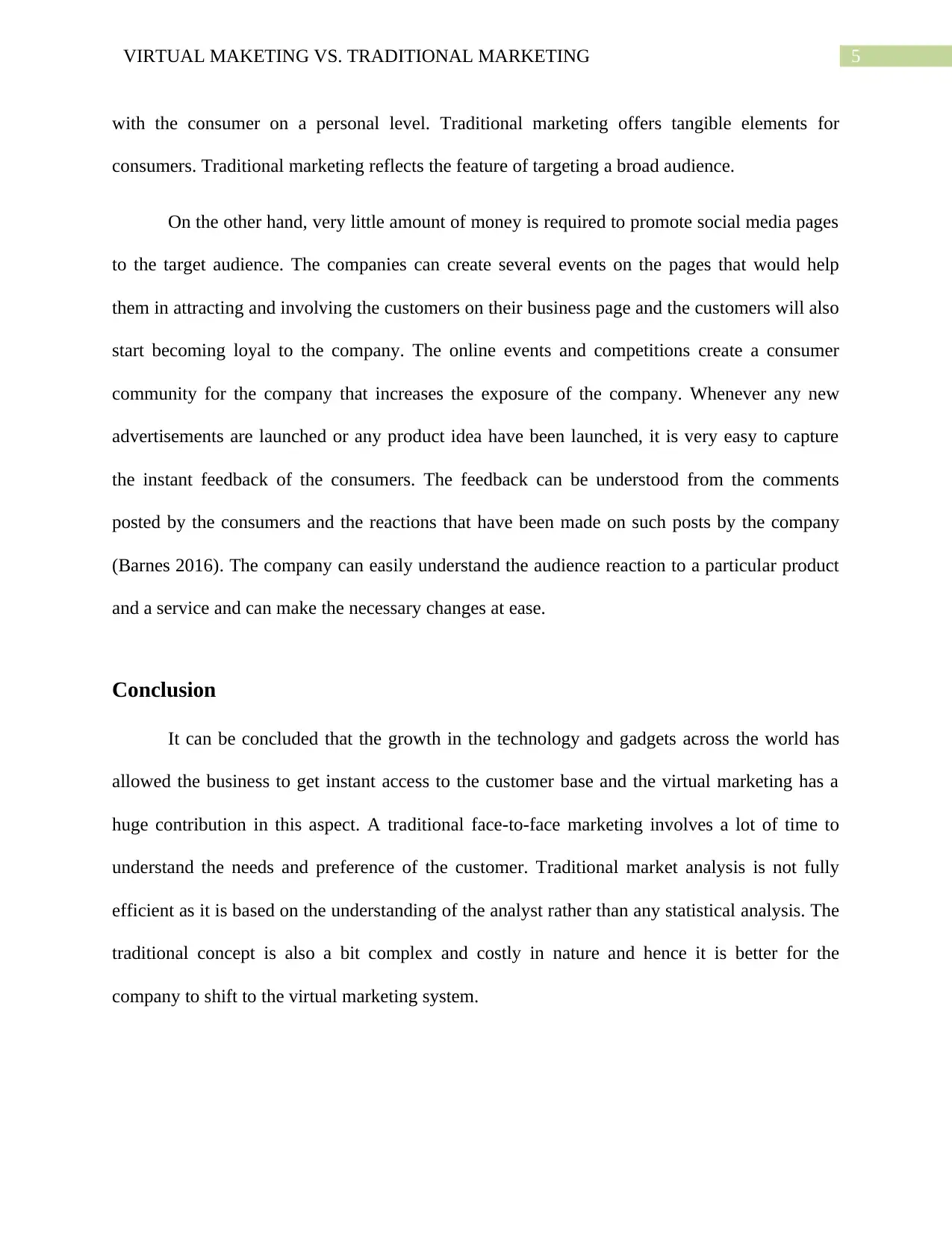
5VIRTUAL MAKETING VS. TRADITIONAL MARKETING
with the consumer on a personal level. Traditional marketing offers tangible elements for
consumers. Traditional marketing reflects the feature of targeting a broad audience.
On the other hand, very little amount of money is required to promote social media pages
to the target audience. The companies can create several events on the pages that would help
them in attracting and involving the customers on their business page and the customers will also
start becoming loyal to the company. The online events and competitions create a consumer
community for the company that increases the exposure of the company. Whenever any new
advertisements are launched or any product idea have been launched, it is very easy to capture
the instant feedback of the consumers. The feedback can be understood from the comments
posted by the consumers and the reactions that have been made on such posts by the company
(Barnes 2016). The company can easily understand the audience reaction to a particular product
and a service and can make the necessary changes at ease.
Conclusion
It can be concluded that the growth in the technology and gadgets across the world has
allowed the business to get instant access to the customer base and the virtual marketing has a
huge contribution in this aspect. A traditional face-to-face marketing involves a lot of time to
understand the needs and preference of the customer. Traditional market analysis is not fully
efficient as it is based on the understanding of the analyst rather than any statistical analysis. The
traditional concept is also a bit complex and costly in nature and hence it is better for the
company to shift to the virtual marketing system.
with the consumer on a personal level. Traditional marketing offers tangible elements for
consumers. Traditional marketing reflects the feature of targeting a broad audience.
On the other hand, very little amount of money is required to promote social media pages
to the target audience. The companies can create several events on the pages that would help
them in attracting and involving the customers on their business page and the customers will also
start becoming loyal to the company. The online events and competitions create a consumer
community for the company that increases the exposure of the company. Whenever any new
advertisements are launched or any product idea have been launched, it is very easy to capture
the instant feedback of the consumers. The feedback can be understood from the comments
posted by the consumers and the reactions that have been made on such posts by the company
(Barnes 2016). The company can easily understand the audience reaction to a particular product
and a service and can make the necessary changes at ease.
Conclusion
It can be concluded that the growth in the technology and gadgets across the world has
allowed the business to get instant access to the customer base and the virtual marketing has a
huge contribution in this aspect. A traditional face-to-face marketing involves a lot of time to
understand the needs and preference of the customer. Traditional market analysis is not fully
efficient as it is based on the understanding of the analyst rather than any statistical analysis. The
traditional concept is also a bit complex and costly in nature and hence it is better for the
company to shift to the virtual marketing system.
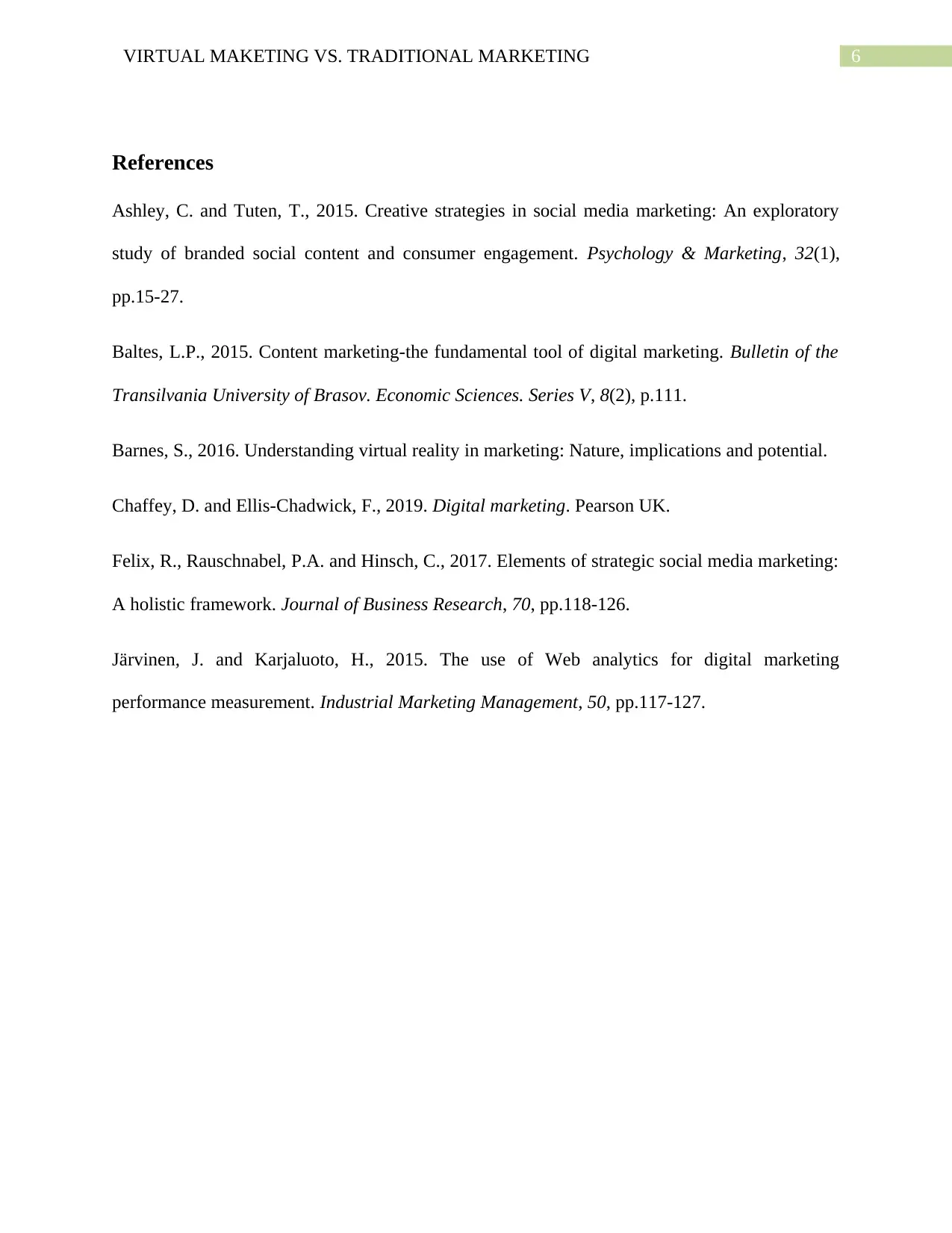
6VIRTUAL MAKETING VS. TRADITIONAL MARKETING
References
Ashley, C. and Tuten, T., 2015. Creative strategies in social media marketing: An exploratory
study of branded social content and consumer engagement. Psychology & Marketing, 32(1),
pp.15-27.
Baltes, L.P., 2015. Content marketing-the fundamental tool of digital marketing. Bulletin of the
Transilvania University of Brasov. Economic Sciences. Series V, 8(2), p.111.
Barnes, S., 2016. Understanding virtual reality in marketing: Nature, implications and potential.
Chaffey, D. and Ellis-Chadwick, F., 2019. Digital marketing. Pearson UK.
Felix, R., Rauschnabel, P.A. and Hinsch, C., 2017. Elements of strategic social media marketing:
A holistic framework. Journal of Business Research, 70, pp.118-126.
Järvinen, J. and Karjaluoto, H., 2015. The use of Web analytics for digital marketing
performance measurement. Industrial Marketing Management, 50, pp.117-127.
References
Ashley, C. and Tuten, T., 2015. Creative strategies in social media marketing: An exploratory
study of branded social content and consumer engagement. Psychology & Marketing, 32(1),
pp.15-27.
Baltes, L.P., 2015. Content marketing-the fundamental tool of digital marketing. Bulletin of the
Transilvania University of Brasov. Economic Sciences. Series V, 8(2), p.111.
Barnes, S., 2016. Understanding virtual reality in marketing: Nature, implications and potential.
Chaffey, D. and Ellis-Chadwick, F., 2019. Digital marketing. Pearson UK.
Felix, R., Rauschnabel, P.A. and Hinsch, C., 2017. Elements of strategic social media marketing:
A holistic framework. Journal of Business Research, 70, pp.118-126.
Järvinen, J. and Karjaluoto, H., 2015. The use of Web analytics for digital marketing
performance measurement. Industrial Marketing Management, 50, pp.117-127.
⊘ This is a preview!⊘
Do you want full access?
Subscribe today to unlock all pages.

Trusted by 1+ million students worldwide
1 out of 6
Related Documents
Your All-in-One AI-Powered Toolkit for Academic Success.
+13062052269
info@desklib.com
Available 24*7 on WhatsApp / Email
![[object Object]](/_next/static/media/star-bottom.7253800d.svg)
Unlock your academic potential
Copyright © 2020–2025 A2Z Services. All Rights Reserved. Developed and managed by ZUCOL.





